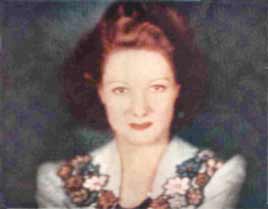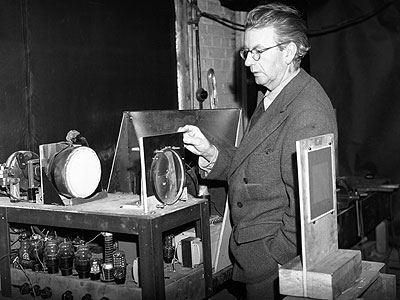

 (Right) An image of aviator Paddy Naismith from the screen of Baird's 1940 colour television receiver (below left). This television picture had 600 lines of resolution, and used a monochromatic cathode-ray tube with a rotating transparent colour wheel in front of it.
(Right) An image of aviator Paddy Naismith from the screen of Baird's 1940 colour television receiver (below left). This television picture had 600 lines of resolution, and used a monochromatic cathode-ray tube with a rotating transparent colour wheel in front of it.
Baird's 1944 vision of the future
 In 1944, the end of World War II was in sight. A British government committee, under the chairmanship of Lord Hankey, was set up to consider the future of television broadcasting and the television industry after the end of the war. Among the many witnesses from the BBC and industry was one private citizen, John Logie Baird. His contribution was given in 6 parts:
In 1944, the end of World War II was in sight. A British government committee, under the chairmanship of Lord Hankey, was set up to consider the future of television broadcasting and the television industry after the end of the war. Among the many witnesses from the BBC and industry was one private citizen, John Logie Baird. His contribution was given in 6 parts:
1. War research and television development
2. Reopening of service on the 1939 standard of definition
3. Television research
4. New television service of radically improved type
5. Home market
6. Foreign market
Part 4 gives Baird's ideas of the long-term technical future of television and it is reproduced below in full. It is interesting to compare this forecast with the actual development of television in the last 60 years.
4. New television service of radically improved type
 The ideal television service should show a picture in colour and stereoscopic relief and should operate on an international standard of the order of definition represented by 1000 lines in conjunction with an International worldwide Television Broadcasting Service.
The ideal television service should show a picture in colour and stereoscopic relief and should operate on an international standard of the order of definition represented by 1000 lines in conjunction with an International worldwide Television Broadcasting Service.
Before this position can be arrived at considerable time must lapse and, in my view, one or more intermediate steps are inevitable.
The first step and the one in which I am most immediately interested in is the introduction of colour and stereoscopic relief and I would like to make clear the position in regard to these branches of television.
Colour and stereoscopic television were shown for the first time when I gave a demonstration at the annual meeting of the British Association in 1928. In 1939 I showed colour television using a cathode ray tube in front of which revolved a disc fitted with colour filters. The system was developed by me during the war, and was also taken up by the Columbia Broadcasting company and the General Electric Company in the United States of America.
A picture (from 1944) of Baird holding the two gun prototype Telechrome. 
The disadvantage of having to use a revolving disc led me to evolve a system with no moving parts.
The first system used was to superimpose optically coloured images produced side by side on the face of a cathode ray tube. This had the disadvantage that the picture on the fluorescent screen could not be received directly. The disadvantage was overcome in a second system, which gives a very bright picture directly on the fluorescent screen without any optical projection.
Stereoscopic television
I have developed several forms of stereoscopic television. The first has the advantage of simplicity and can be used with a two colour system with no alteration to the receiver. The audience must, however, [wear] coloured glasses. In the second system no glasses are required, the picture being viewed directly. It is restricted to a few persons sitting in a fixed position. In this system the restriction is overcome and the picture can be viewed from any position, no glasses being required.
A diagram of the 3-gun Telechrome television picture tube. Three colour reproduction was by means of three electron beams acting on a screen. The screen was coated with phosphors which emitted the three colour bands as required.
 The best results have been given by a three colour system showing stereoscopic relief without the aid of glasses. A three colour system such as this gives better colour rendering than a two colour, and stereoscopy without glasses is much to be preferred to the use of glasses. A two colour system gives however, so many practical advantages, and so greatly simplifies the apparatus both for colour and stereoscopy that, in my view the most practical apparatus that I have developed - for present transmitting conditions - is a two colour 600 line stereoscopic system.
The best results have been given by a three colour system showing stereoscopic relief without the aid of glasses. A three colour system such as this gives better colour rendering than a two colour, and stereoscopy without glasses is much to be preferred to the use of glasses. A two colour system gives however, so many practical advantages, and so greatly simplifies the apparatus both for colour and stereoscopy that, in my view the most practical apparatus that I have developed - for present transmitting conditions - is a two colour 600 line stereoscopic system.
This has the following advantages:
1. Colour pictures sent out can be received on pre-war television sets without alteration as monochrome pictures.
2. No change is required in present wireless transmitters and only small change in studio equipment.
3. Pictures in stereoscopic relief can be received on colour receiving sets without any alteration in these sets.
4. No revolving discs or moving parts necessary.
5. Definition can be increased to 600 lines or the present 405 lines used.
If the British Broadcasting Corporation decided to add colour and stereoscopy on this system attachments could be fitted to their existing apparatus so that items in colour or in stereoscopic relief could be introduced into their programmes, possibly in the first place as experimental interludes.
With his childhood friend, Jack Buchanan, Baird formed a new company with the idea of creating an independent television company broadcasting a colour TV service.